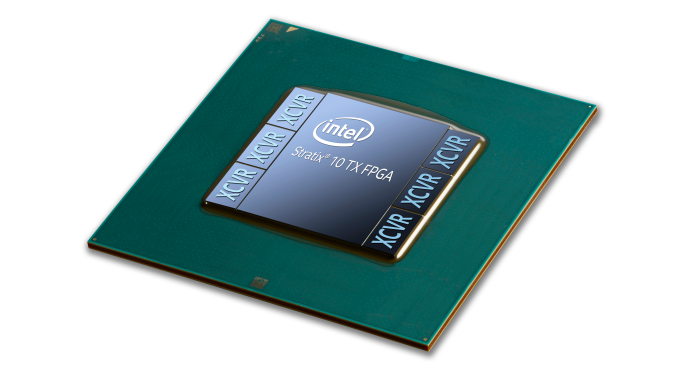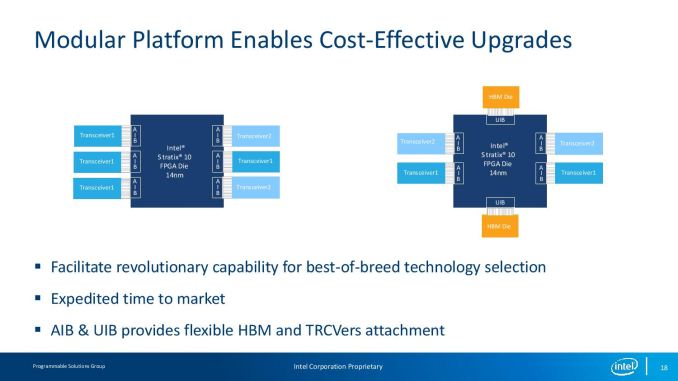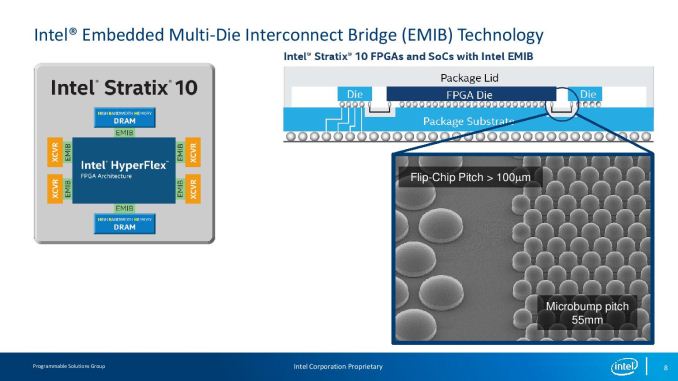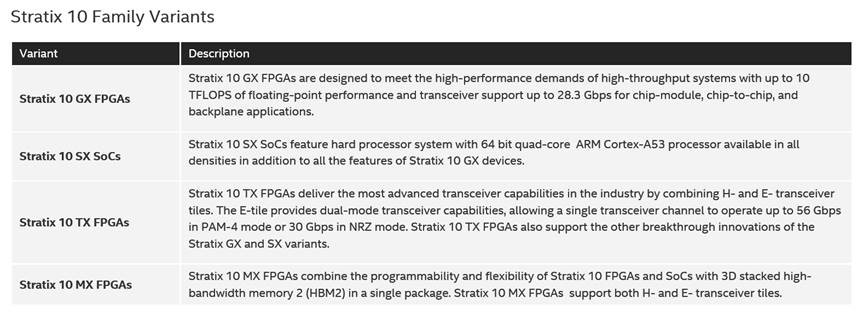Intel Launches Stratix 10 TX: Leveraging EMIB with 58G Transceivers
by Ian Cutress on February 26, 2018 9:00 AM EST- Posted in
- Enterprise
- Intel
- Trade Shows
- FPGA
- Altera
- Stratix
- EMIB
- Stratix 10
- EW2018

One of the key takeaways from Hot Chips last year was that Intel’s EMIB strategy was going to be fixed primarily in FPGAs to begin with. Intel instigated a bridge and chiplet strategy: with the right FPGA, up to six different chiplets can be added via EMIB in a single package. This is well beyond the single EMIB implementation coming to consumers. Intel has already been selling its Stratix 10 family of FPGAs that have additional functionality through EMIB for a number of months, however today Intel is announcing the latest member of that family, one that has the ability to include 58G transceivers: the Stratix 10 TX.
Intel will offer different variants of the Stratix 10 TX, from 600k logic elements with two chiplets up to 2.8 million logic elements with six chiplets. Five of the tiles are capable of taking the new 58G transceivers, enabling up to 144 transceivers in a single package. The sixth tile is used for PCIe. While the central FPGA is built on Intel’s 14nm process technology, the transceivers will be built upon TSMC’s 16FF process, due to Altera’s history of using TSMC for its analog hardware. Intel states that the transceivers in play can go down to 1 Gbps if needed, enabling backwards compatibility with existing networks. These transceivers were first demonstrated back in March 2016, finally making it to market.
Intel is calling the new transceivers dual-mode 58G, with 4-levels of pulse-amplitude modulation (PAM4) and 30 Gbps non-return-to-zero. Previously these were (and have been called) 56G, but Intel is using the term 58G because it believes that its solution will perform better than other 56G solutions on the market, enough to call it a 58G device.
The aim for these new Stratix 10 devices is for driving networking bandwidth needs for centralized base stations and network virtualization. The latter here is critical for 5G implementation, where compute happens in edge networks and VMs are transferred around to enable compute that has to happen closer to the device, especially with software defined networking. The Stratix 10 also features a range of IP cores, for 100GbE MAC and FEC, and the transceivers are built through a range of Intel and third-party IP.
We are told from Intel that using EMIB in conjunction with the new chiplets enables for a much lower power product than previous designs. Intel offers customers substantial training, but EMIB implementations are essentially transparent to the design: the upside being bandwidth related and the ability to create use cases from that functionality.
Alongside the Stratix 10 TX, Intel will also be offering a TX version with HBM2 (high-bandwidth memory). Within the largest design, the package can have two 4GB HBM tiles paired with three 58G transceivers and one 28G transceiver. That last one is 28G because it also has a hard PCIe connection. The HBM2 memory can run at either 800 MHz or 1 GHz depending on the product.
Intel is shipping the Stratix 10 TX family from today.














6 Comments
View All Comments
HStewart - Monday, February 26, 2018 - link
I believe this is 2nd product to use Intel EMIB which was mention earlier about Intel 4808G which combines what looks like assume 8th generation mobile CPU alone with AMD Discrete graphics in small package with very fast connection between CPU and GPU and Graphics memory.What I expect is that EMIB technology will show it flexibility with more components in the futures. I also believe that it came from technology that Intel inherited when it purchase Altera.
I played a little with Altera FPGA package for Arduino but what would be cool if intel developed a NUC with Intel CHIP combine with FPGA in a package for development and exploration purposes.
name99 - Monday, February 26, 2018 - link
"Previously these were (and have been called) 56G, but Intel is using the term 58G because it believes that its solution will perform better than other 56G solutions on the market, enough to call it a 58G device."Nigel Tufnel: The numbers all go to eleven. Look, right across the board, eleven, eleven, eleven and...
Marty DiBergi: Oh, I see. And most amps go up to ten?
Nigel Tufnel: Exactly.
Marty DiBergi: Does that mean it's louder? Is it any louder?
Nigel Tufnel: Well, it's one louder, isn't it? It's not ten. You see, most blokes, you know, will be playing at ten. You're on ten here, all the way up, all the way up, all the way up, you're on ten on your guitar. Where can you go from there? Where?
witeken - Monday, February 26, 2018 - link
It does 58Gbps. altera.com/txname99 - Monday, February 26, 2018 - link
The TECHNICAL Intel session referred to it as 56Gbps.https://twitter.com/david_schor/status/96820933292...
If Intel thinks they can redefine standard numbers whenever they feel like it, maybe they should stop complaining that "Foundry 10nm isn't REALLY 10nm, and their 7nm isn't REALLY 7nm", no?
thetuna - Monday, February 26, 2018 - link
Seriously... they didn't define G even once.CharlotteSmith - Saturday, December 28, 2019 - link
144 transceivers in a single package? That's huge. I read about it at https://www.assignmentgurus.co.uk/ then I come here with the referral link just to confirm it.